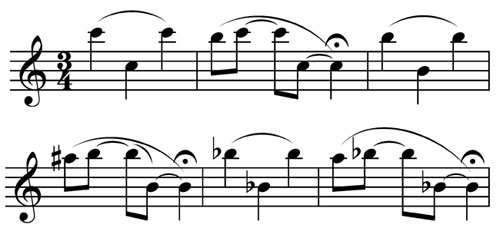 If you are in the market for an alto or bass flute, you are in luck. There are more choices in more price ranges today than ever before. Manufacturers have added more models and options, and new makers are coming into the market as well. Begin gathering information about six months before your intended purchase. Ask for opinions from flute chat rooms, other alto and bass players, flute choir directors, repair people, and flutists in your area. Talk to people who have no financial interest in your intended purchase. Salespeople are supposed to make their instruments sound like the best ever.
If you are in the market for an alto or bass flute, you are in luck. There are more choices in more price ranges today than ever before. Manufacturers have added more models and options, and new makers are coming into the market as well. Begin gathering information about six months before your intended purchase. Ask for opinions from flute chat rooms, other alto and bass players, flute choir directors, repair people, and flutists in your area. Talk to people who have no financial interest in your intended purchase. Salespeople are supposed to make their instruments sound like the best ever.
State flute festivals usually have an area for exhibitors, so find out what stores and makers are coming and if they will have alto and basses for you to try. Do not settle for whatever happens to be available in your town. The only way to find the best instrument for you is to play as many of them as possible.
The best selection of alto and bass flutes, any flutes actually, is at the National Flute Association convention (Anaheim, August 2010). It is worth the trip to be able to try many different ones in a short period of time.
If you can’t wait until August, there are music stores that will send instruments on a trial basis. Usually they request a credit card number as collateral. Be sure to ask what their return policy is including whether there is a restocking fee if you return the instrument. Deal with an established, well-known music store that will stand behind the products if something goes awry.
Just because a flute is offered for less money doesn’t mean it’s a bargain. You usually get what you pay for. If no flute player has ever heard of the brand you found online, approach it with extreme caution.
Sterling vs. Silver plate
I believe that C flutes generally have better tone when they are made of silver, but this is less critical for altos and basses. The larger the instrument, the less important the materials are that makeup that instrument. A sterling headjoint on an alto was probably designed more carefully because it was made out of silver, and it should produce a better tone than a plate version of the same model.
I find that an alto with a sterling head and body is heavy to hold, and the tone is not appreciably better. Play one for 15 minutes without stopping to see how you feel. If your arms and hands don’t hurt and the tone pleases you, it may be a good option for you.
Basses are primarily silver plate because sterling would increase the weight of the instrument too much. Focus on the headjoint design, what the bass sounds like, how the instrument responds, and what the mechanism feels like under your hands.
Key Layout
There is great variety in key layout from maker to maker on altos and basses. Test a variety of flutes to find the ones that allow you the most comfort and agility. One important factor to consider is how easily the footjoint keys can be maneuvered by the little finger. Because we buy low flutes for their luscious low notes, make sure the keys are easy to reach. Make sure your finger does not get stuck between Eb and Db or that getting to low C does not require too much right hand twisting.
Curved vs. Straight Head
If you are buying an alto that several people will share, get one that comes with both a curved and straight headjoint. People with short arms will appreciate being able to play without cramping their right hand, and others will appreciate the improved intonation of a straight tube. Most entry and mid-level instruments can be purchased with both heads.
If you are buying the alto for yourself, you have to decide if you want a straight or curved head. For intonation reasons, I believe a straight head is preferable. Because key layout varies from maker to maker, some flutes with straight heads will be fine, while others will be uncomfortable. Make sure you can play the alto flute with a straight head continuously for 15 minutes without discomfort in your right hand.
If you are like me and have short arms, only a curved head alto will do. The intonation of the third octave is, unfortunately, ¼ step sharp. However, it is better to have an intonation problem than a hand problem. To see how to line up an alto or bass with a curved headjoint, refer to my YouTube video MaZraz5LZZ0 for alto and FpkSy2mv2F0 for bass .
Bass Support Systems
Some basses come with a crutch for the left hand that attaches to the bass and fits in between the thumb and index finger. It helps stabilize the instrument, but it is sometimes too big and painful to use. It is important to find an instrument that fits your hand comfortably. I have found that a non-slip cushion for flute called a “hand positionner” that is available through BG Franck Bichon keeps my bass from slipping around.
Two companies currently make vertical basses. They are worth trying if your right arm is dying holding up the regular bass. Some basses have a narrow bore option that is also helpful for people with small hands.
Another bass flute comes with a graphite rod that screws into the bottom of the instrument with a pivot connection. The graphite rod only comes in one length that may or may not work for you, but it can be a huge help in long rehearsals.
Playing Tests
A C-flute player can usually get a sound out of an alto, but getting a sound on a bass is a different story. If you are shopping for a bass but don’t yet play one, have someone else try it for you. Pay special attention to the lowest notes; they are the reason you are buying the instrument. Don’t buy an instrument until you can hear what it can do. You should still test how comfortable it is to hold, even if you are having trouble getting a sound.
To check an instrument, first try a simple tune that starts fairly low and goes down to the bottom of the range. Something like “Joy to the World,” “The First Noel,” or “Moon Over the Ruined Castle” would work well. If the low register is weak or hard to get out, go no further with that instrument. A weak low register is a deal breaker for me.
Try some of your favorite melodies. and see if you like the sound. Ideally, an instrument should have that wow factor. You play it and the sound connects with you at an emotional level. You feel you just have to have this instrument. If you dislike the sound, there is no point in continuing further.
Intonation Test
The next test is intonation. Tune to an A. It is critical that the low octave be close to in tune, so play mf down a C Major scale for one octave and see what the tuner says. I have played many basses and some altos that have a flat low register. If it is more than 10 cents flat on C3, C#3 or D3 at mf, find another instrument to try. It is very difficult to bring pitch up in the low octave, especially at soft dynamic levels, and it is not always possible to compensate for a flat low octave by pushing in, which also makes the third octave even sharper. You don’t want to fight with the instrument in precisely the area that is most important.
If the instrument passes this test, go up an easy one-octave scale slowly and look at the pitch of each note on a tuner. Use no vibrato. Test the C#2 – it is usually less sharp on alto and bass than on C flute. The C2 is also not sharp as it is on a C flute. Find out how much adjusting you’ll have to do for these two notes. The first and second octaves should be pretty well in tune. If they are not, move on to another instrument.
The entire third octave of a bass and a curved headjoint alto is generally ¼ step sharp, mainly because manufacturers have not yet figured out how to make a continuous taper through the tight curve of the headjoint. This is why alto flutes with straight heads are usually better in tune. However, each flute has its own unique problems. There is no perfect instrument.
For curved altos and basses, you will need to learn some embouchure adjustments and some alternate fingerings for the third octave.
Mechanical and Tonal Response
If the instrument passes the intonation test, try fast two-octave scales and arpeggio patterns. Evaluate the crispness or sluggishness of the mechanism and how easily or not the instrument moves through the different registers. Then move on to slurring big intervals. My current favorite is this pattern:

Continue on down with this exercise until your bottom note is your fingered low C. This test should tell you how easy it is to find that spot where the notes speak cleanly.
Rapid tonguing is the next test. Go up and down some tongued scales and try any fast tonguing passage you know. Notice how well the flute responds. Check whether you can play single short notes. E2 and F2 can be less responsive. If you find an instrument that can play these cleanly, count your blessings.
If the instrument passes all these tests, you like the tone, and you can purchase the one you have tested, take the plunge!






